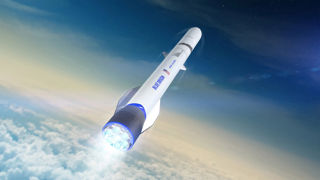
New Glenn, Blue Origin's Flagship Launch Vehicle
- 8th Oct 2024
- Author: Ed Kellond-Turner
Blue Origin's New Glenn rocket is set to launch no earlier than November 2024, carrying a Blue Ring spacecraft platform. But who are Blue Origin? And what celestial targets do they have their sights on?
Blue Origin
Amazon's Jeff Bezos founded Blue Origin in 2000, with "a vision of millions of people living and working in space for the benefit of Earth". In 2021, Blue Origin finally lifted off the launch pad with their New Shepard rocket, named after the first American astronaut Alan Shepard. Just like Shepard's Mercury-Redstone capsule in 1961, New Shepard flew on a suborbital trajectory, allowing the four space tourists onboard to experience weightlessness for a short amount of time before heading back to Earth.
Though there have been a few mishaps, Blue Origin continues to successfully launch New Shepard, recovering and reusing the booster and crew cabin each time, usually with six space tourists aboard. Not only that, but they have begun production of their new BE-4 engines that were recently used by the new Vulcan Centaur launch vehicle.
New Glenn
New Glenn will become Blue Origin's flagship launch vehicle when it takes to the skies carrying a prototype Blue Ring spacecraft platform. New Glenn is an absolute giant of a rocket, standing nearly 100 metres tall and 7 metres wide, and being able to carry around 45,000 kilograms to low Earth orbit.
Just like New Shepard, New Glenn's name comes from American spaceflight history. In 1962, John Glenn became the first American to orbit the Earth. Unlike Glenn's Mercury-Atlas rocket, New Glenn will not only launch into orbit, but also land the first stage safely back on Earth, with a minimum of 25 flights per booster. Not only this, Blue Origin has begun 'Project Jarvis', which includes plans to make the upper stage reusable as well.
Blue Origin have stated that New Glenn is "key to unlocking a future where people and heavy industries are moved into space to preserve Earth".
The Moon and Mars
Blue Moon is Blue Origin's contribution to the Artemis program, and the spacecraft will carry humans and cargo to the lunar surface. Currently the first landing of four astronauts with Blue Moon is scheduled for 2029 as part of the Artemis V mission. The lander is twined with a cislunar tug that will transport the spacecraft to lunar orbit
Blue Moon will make use of brand new technology to limit the amount of cryogenic fuel that boils off into space, something I'm sure will be very useful for the Artemis program as well as future missions to Mars.
The Escape and Plasma Acceleration and Dynamics Explorers, or EscaPADE mission are twin spacecrafts being launched as part of NASA's SIMPLEx mission, with the design of the spacecraft coming from Rocket Lab.
EscaPADE will demonstrate low-cost planetary exploration while studying how Mars' magnetosphere interacts with the solar wind, and how this contributed to the planet's atmospheric loss.
Originally, these spacecraft were to hitch a ride on the Psyche mission, being dropped off during a flyby of Mars as Psyche continued its journey to its target: the asteroid 16 Psyche. Unfortuntely, Psyche was delayed and launched in October 2023, meaning it would no longer swing past Mars, hence EscaPADE would need a new launch vehicle. Luckily, New Glenn is here to save the day.
Our fingers are crossed that the New Glenn launch goes off without fault, as it will provide yet another reusable rocket in the launch market, further lowering costs and opening space for even more people. Not only that, but payloads currently scheduled for launch in 2025 get us very excited for near future human lunar exploration.
Full credits / references
(Banner image) Artist impression of the New Glenn launch. Credit: Blue Origin
(1a) Alan Shepard during his flight aboard the Freedom 7, the first crewed American spaceflight. Credit: NASA
(1b) New Shepard taking off on a suborbital spaceflight. Credit: Blue Origin
(2a) John Glenn and the Mercury "Friendship 7" spacecraft on 20th Feb 1962. Credit: NASA
(2b) The New Glenn rocket fully stacked on the launch pad. Credit: Blue Origin
(3a) Blue Origin's Blue Moon on the surface of the Moon. Credit: Blue Origin
(3b) The twin EscaPADE spacecraft in orbit around Mars. Credit: NASA







